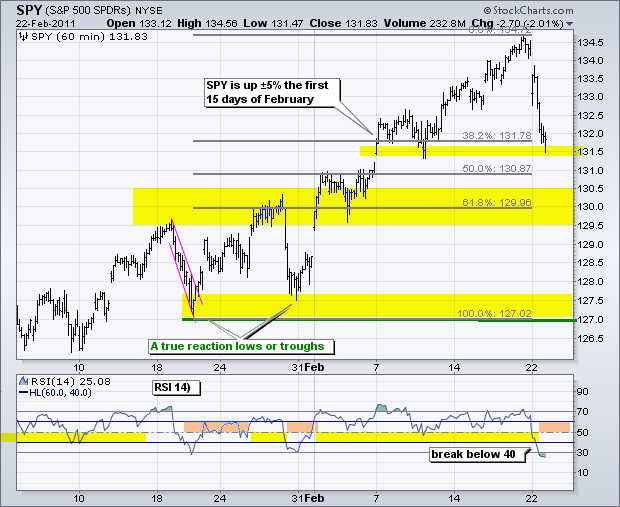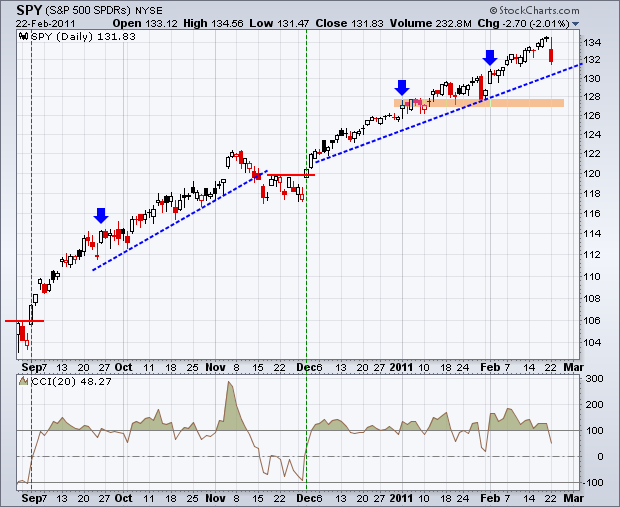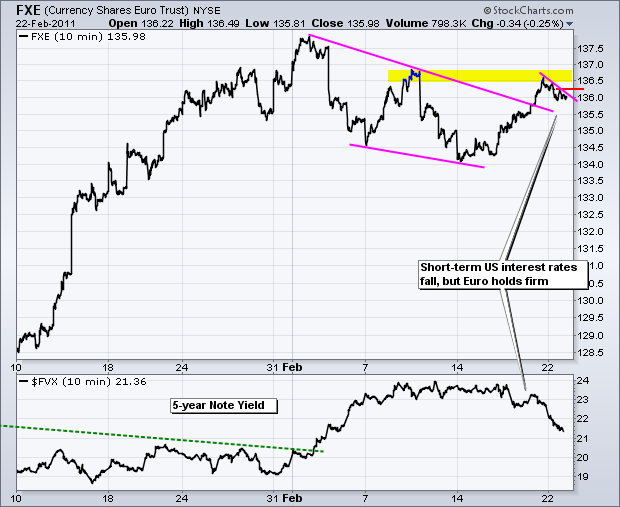On the 60-minute chart, the S&P 500 ETF (SPY) hit its first support zone in the 131.5 area. This zone stems from the consolidation the second week of February. It is important to note that the gap down held and the ETF continued lower after the first wave of selling pressure. This inability to bounce immediately suggests that the correction may extend a few more days. Selling pressure was also intense as market breadth was the weakest since mid August and downside volume was the highest since the late January decline. A small oversold bounce is possible from current levels and the gap zone around 134 marks the first resistance zone to watch. Given the overbought situation on the daily chart, severe selling pressure on Monday and continued uncertainty surrounding the Middle East and Africa, I would not be surprised to see this correction extend to the 130 support zone.


Given the big flight-to-safety trade yesterday, I would have expected a bigger gain from the Dollar and loss from the Euro. Perhaps the surge in bonds and plunge in yields kept pressure on the Dollar. In any case, the Dollar did not act like it should have on Monday and there is a message in this price action. The Euro Currency Trust (FXE) declined the first two weeks of February and formed a falling wedge. A surge last week broke the wedge trendline and the ETF consolidated around 136-136.5 the last two days. A break above this consolidation would be quite bullish for the Euro.

Key Economic Reports/Events:
Feb 23 - 07:00 - MBA Mortgage Index
Feb 23 - 10:00 - Existing Home Sales
Feb 24 - 08:30 - Jobless Claims
Feb 24 - 08:30 - Durable Orders
Feb 24 - 10:00 - New Home Sales
Feb 24 - 11:00 - Oil Inventories
Feb 25 - 08:30 - GDP
Feb 25 - 09:55 - Michigan Sentiment
Charts of Interest: Thursday in separate post.
-----------------------------------------------------------------------------
This commentary and charts-of-interest are designed to stimulate thinking. This analysis is not a recommendation to buy, sell, hold or sell short any security (stock ETF or otherwise). We all need to think for ourselves when it comes to trading our own accounts. First, it is the only way to really learn. Second, we are the only ones responsible for our decisions. Think of these charts as food for further analysis. Before making a trade, it is important to have a plan. Plan the trade and trade the plan. Among other things, this includes setting a trigger level, a target area and a stop-loss level. It is also important to plan for three possible price movements: advance, decline or sideways. Have a plan for all three scenarios BEFORE making the trade. Consider possible holding times. And finally, look at overall market conditions and sector/industry performance.
